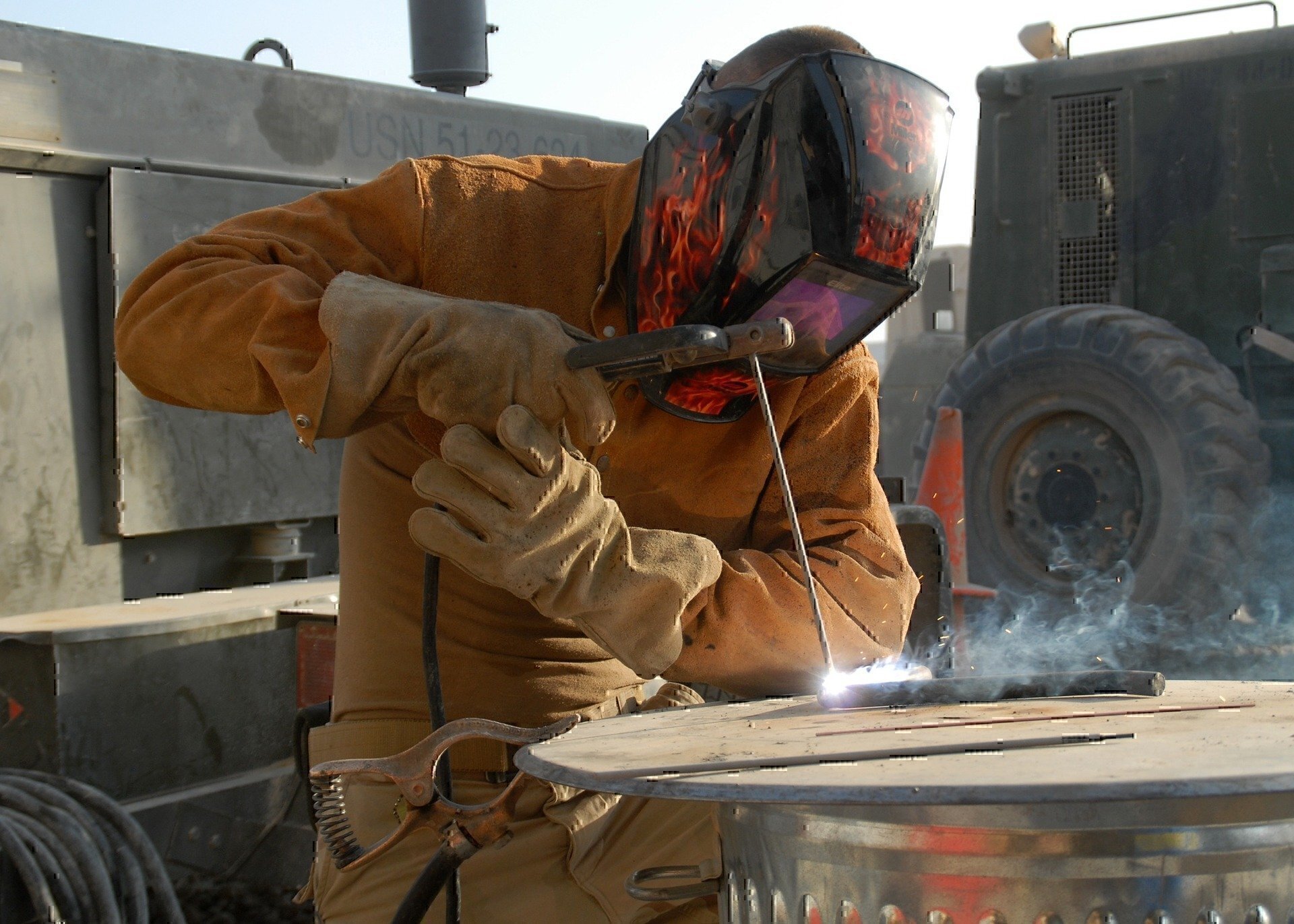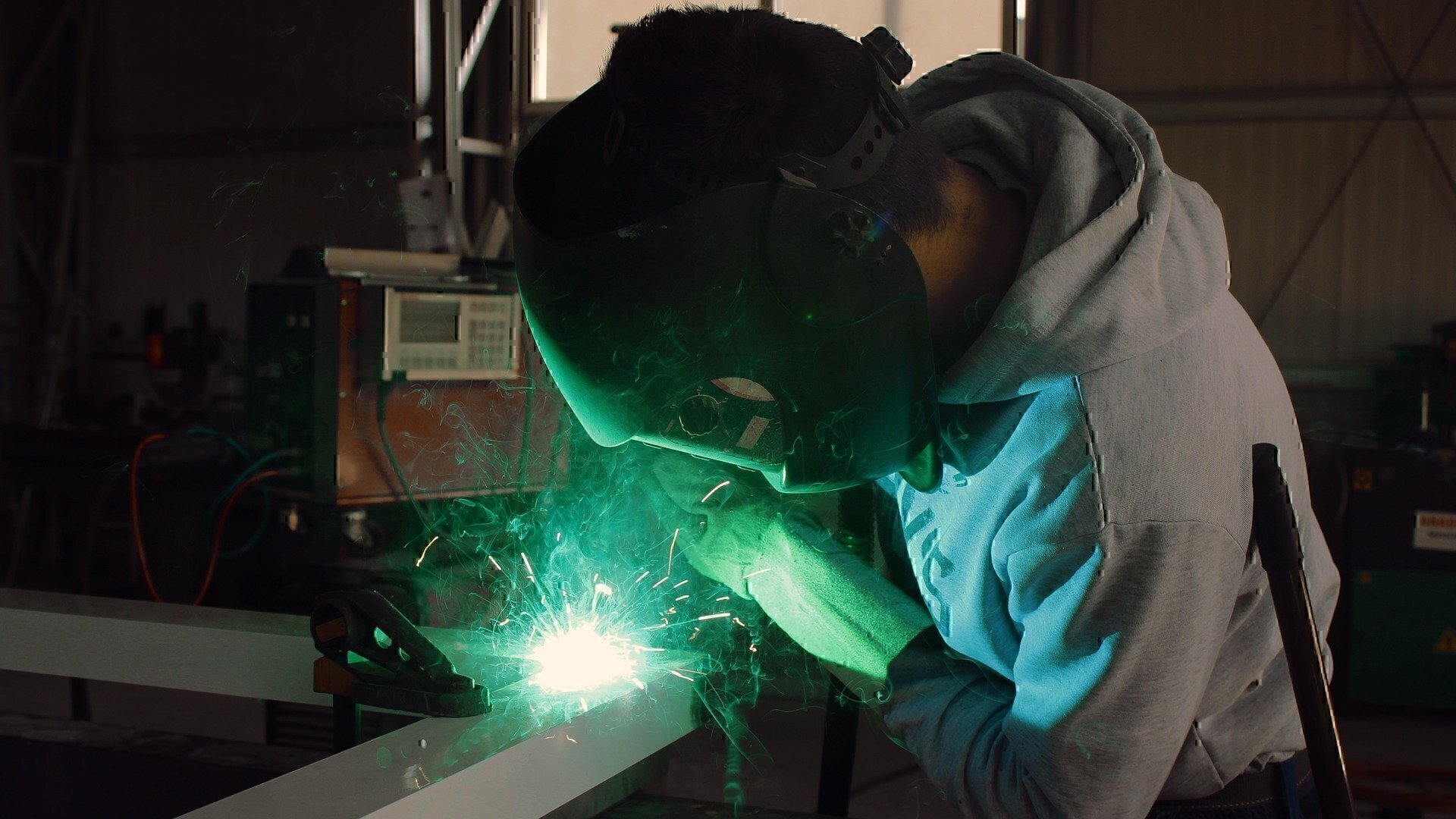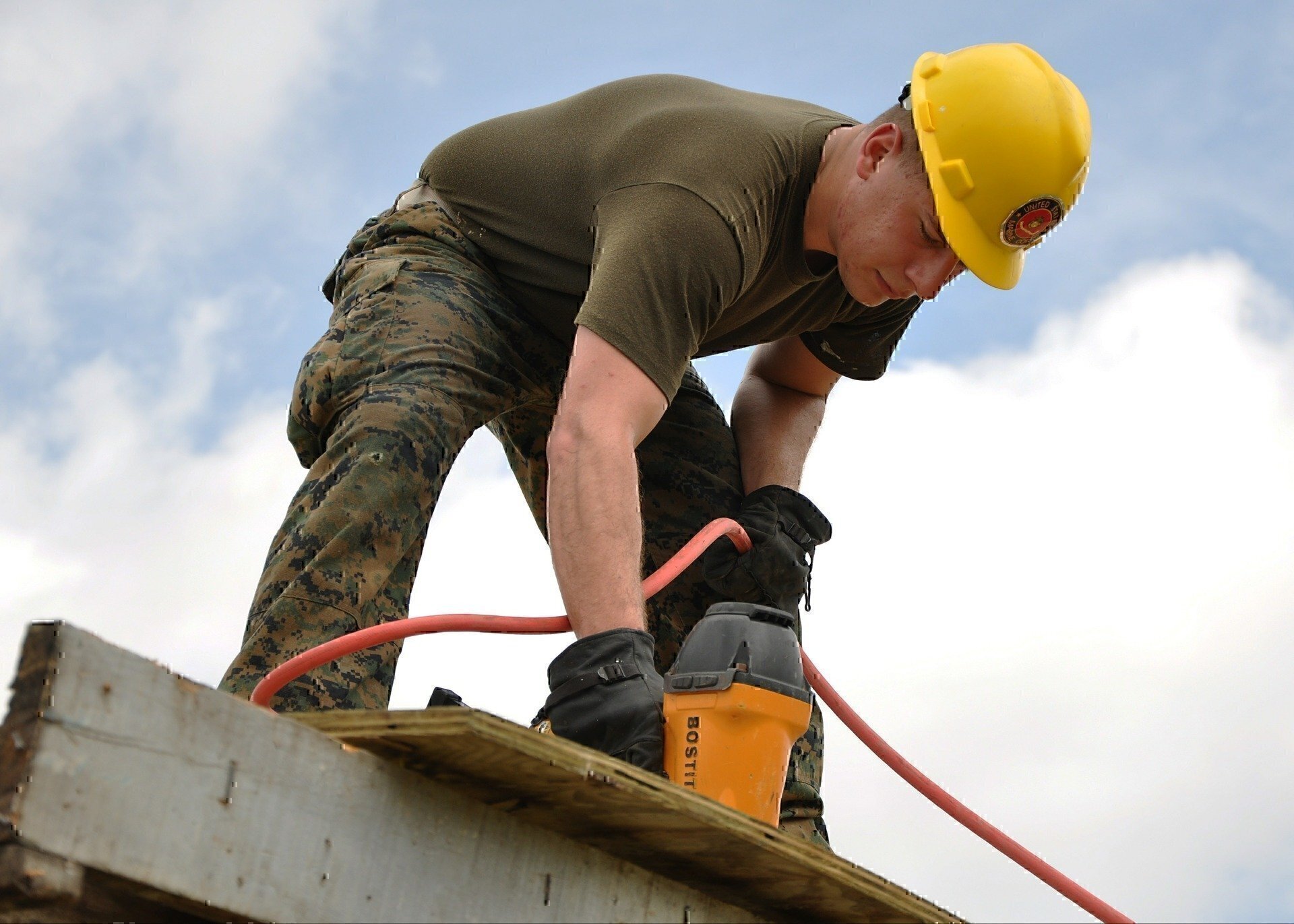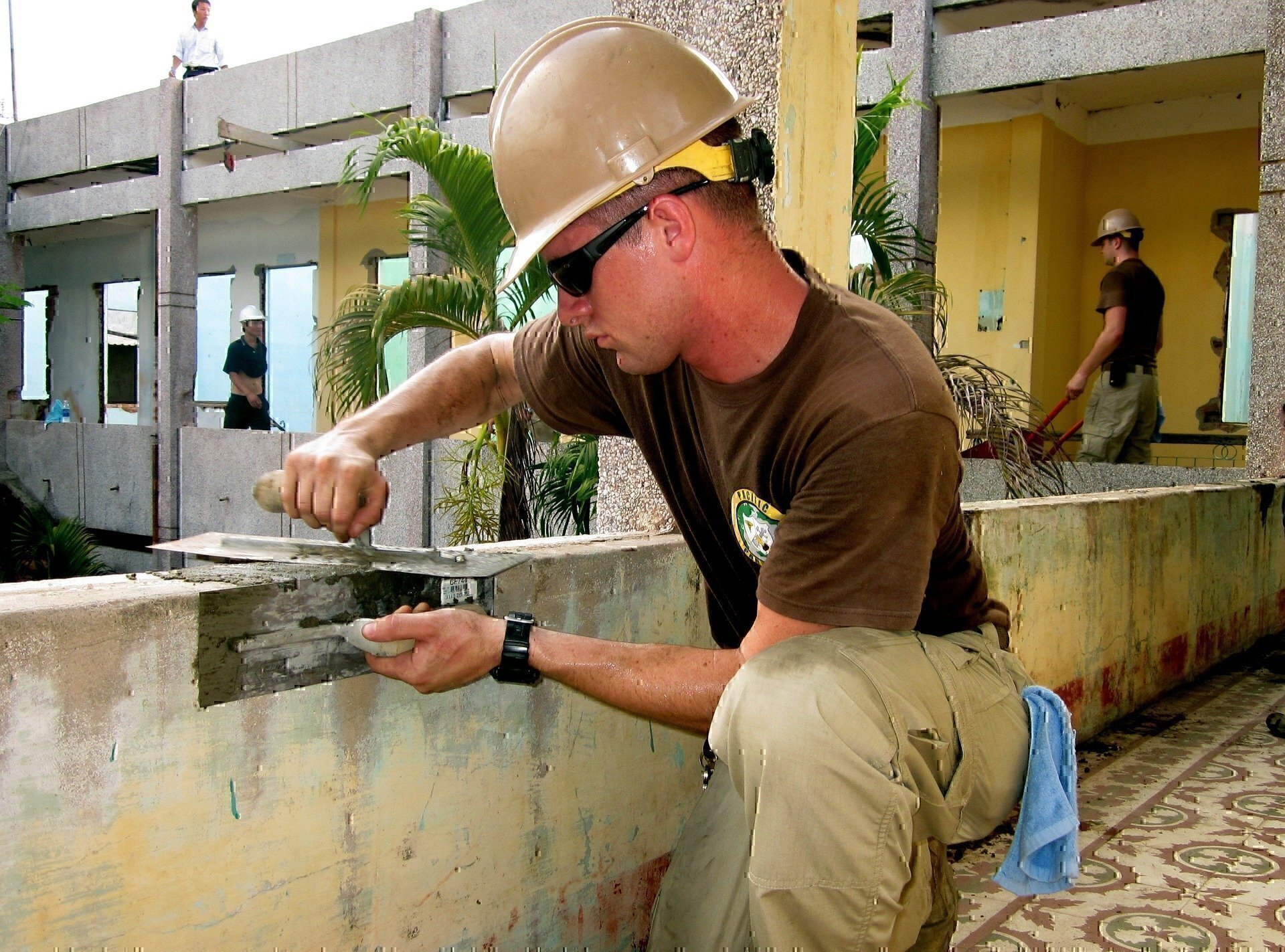There are so many different types of jobs in construction, which makes it an appealing career option for veterans. You can use many different types of skills you learned during your service to succeed in a number of construction jobs.
Here are 5 more great jobs in construction.
1.) Welders
Welders cut, meld, shape and fuse various kinds of metals together. Welding is the most common technique for permanently bonding two pieces of metal. Because of its strength, welding is used in a a wide array of industries such as shipbuilding, the automotive industry and many other manufacturing industries world wide.
Welding is also used on construction sites to fuse steel and metal beams together for support. The most common type of welding is arc welding, which uses electrical currents to produce heat and melt metal. There are over 100 different kinds of welding, with each being deployed based on the types of metals being used and the environment in which the work is being done.
Work Environment of Welding Jobs
Welders typically work in several different settings. Depending on the job a welder may work outdoors, sometimes in inclement weather, or they may work in a factory. Welders may also need to work on elevated surfaces such as scaffolds, bridges or rooftops. There is sometimes heavy lifting involved with being a welder as well.
As a result of working with very hot metals, being exposed to gases and other dangerous situations, welding jobs have one of the highest rates of injury and illness of any occupation.
READ NEXT: 10 WORST JOBS TO HAVE IN 2018
How to Become a Welder
In order to become a welder you typically need a high school diploma or equivalent, as well as some sort of technical or on-the-job training. In addition to receiving on-the-job training, you can also attend a vocational school or a private welding school to learn the craft. If you received welding training during your time in the military you are one step ahead of the game!
Some knowledge in electricity and computers may also make you a valuable candidate for welding jobs. There are also specific certifications you can earn, such as becoming certified as a welding inspector.
Outlook for Welding Jobs
According the Bureau of Labor Statistics the average salary for a welder was $40, 240 as of May 2017. Employment of welders is expected to raise 6% by 2026, which is about as fast as the average occupation is expected to grow in that same time.
Employment growth is expected for welding jobs because of how important they are in many different industries and manufacturing processes. Also, as the country’s infrastructure continues to age, there will need to be welding repairs performed on bridges, buildings, highways and other structures.
Job prospects will be better for more experienced welders and welders who would be willing to relocate, as well as welders who know several techniques of welding.
2.) Carpenters
Carpenters use tools to cut, shape and mold wood, plastic, drywall and other materials. In their work, carpenters use a variety of hand tools such as levels, squares, chisels and power tools. They must be able to follow blueprints and work within the dimensions of a given area, while still performing their job up to standards.
Carpenters will be hire to perform tasks such as building/structure inspections and constructing building frameworks. They may also be required to direct other laborers to perform their tasks as well.
Types of Carpentry Jobs
Rough Carpenters: Rough carpenters build rough wooden structures, such as concrete forms and scaffolds. They also may build tunnel, bridge, or sewer supports and temporary frame shelters. They work off of sketches and blueprints.
Construction Carpenters: Construction carpenters construct, install, and repair structures of wood, plywood, and wallboard, using hand tools and power tools.
READ NEXT: DIVERSE INDUSTRIAL ENGINEERING JOBS
Work Environment of Carpentry Jobs
Due to the nature of their work, Carpenters often work at construction sites or homes of somebody who has hired them. Carpenters must be in good physical shape, as their work requires them to shift from sitting, standing and lifting quite often.
Carpenters also have one of the highest rates of illness and injury of any profession in the United States. The most common injuries are strains from lifting, falls from ladders and cuts from sharp tools and objects.
How to Become a Carpenter
Typically, a high school diploma or equivalency is required to become a carpenter. Carpenters must be well versed in mathematics, as measurements, fractions and other numbers are dealt with regularly.
Most carpenters learn their craft through on the job experience or through an apprenticeship.
Outlook for Carpentry Jobs
According to the Bureau of Labor Statistics, the average salary for carpentry jobs was $45,170 as of May 2017. The employment rate for carpentry jobs is expected to rise 8% by 2026, which is about average for all occupations.
As the population continues to grow, carpenters should see demand for their work increase, as they will need to build new homes for the growing population. One hindrance to the growth of carpentry jobs could be prefabricated components of homes and buildings, which allow components of structures to be easily assembled on job sites.
3.) Masons
Masons must be able to read blueprint plans about what a project is going to look like, and then lay patterns and formations of materials according to those plans. They are also required to cut materials to size and create mixtures of materials that will be used to build their structures.
Masonry jobs require laborers to use many different tools to complete their daily tasks. They will use levels to ensure surfaces and foundations are flat and secure. Masons will also use different kinds of power tools to smooth, clean and polish surfaces. Because the materials they use are so common in construction, masons are important to the construction industry.
Types of Masonry Jobs
Brickmasons: Often times called bricklayers, build and repair walls, floors, ceilings and other structures that are made out of brick.
Cement Masons: Place and finish project made out of concrete. There may be special designs or finishing techniques cement masons use to make a project unique.
Stonemasons: Build stone walls as wells as set floors and other structures made out of special stone. Stonemasons work with either natural-cut stone like marble and granite, or artificial stones made from cement and stone chips.
Work Environment of Masonry Jobs
Masons typically work in outdoor settings, although it is not uncommon to have projects inside of buildings. Masonry jobs can be very strenuous, and involve lifting heavy objects. Masons will need to bend and kneel to complete tasks, which can wear on their bodies over the years.
Because of their strenuous work, brickmasons and block masons have a higher rate of injury than average occupations in the United States.
How to Become a Masonry Worker
Masons are typically required to have a high school diploma or equivalent, although years of experience may be an adequate substitution in some cases. Many technical schools offer programs teaching masonry, and sometimes they may work in conjunction with apprenticeship programs to help students land jobs.
Masons learn their trade through apprenticeships and on-the-job training programs, although some may learn from an experienced mason on a job site.
Outlook for Masonry Jobs
According to the Bureau of Labor Statistics, the average salary for a masonry worker was $42,900 as of May 2017. Masonry jobs are expected to increase 12% by 2026, which is faster than the average occupation in the United States is expected to grow over the same period of time.
As a result of the increasing population, the demand for masons will increase. They will be called on to work on projects to build commercial buildings, parks, sidewalks and other public structures. Cement masons will be needed to repair highways and roads. Brickmasons will see their market increase to work on buildings, hospitals and schools.
The growing job market makes it a great career choice for military veterans who don’t mind a sometimes physical job.
4.) Pipefitters
Pipefitters install and repair pipes that carry liquids and gases to and from homes, buildings and factories. In a typical day a pipefitter may be required to provide estimates for work, examine pipes for problems and then repair those pipes. A pipefitter must have the knowledge of what kind of pipes must be used for a specific job.
Pipefitters are commonly used to install more intricate, bigger pipe systems, like those of power plants. Plumbers can typically handle the work that is done in homes, but pipefitters are still sometimes needed for residential jobs. Pipefitters typically work on industrial jobs where pipes will be used to move gases, toxic liquids and acids. They also may be called on to work on heating systems for large buildings.
Work Environment of Pipefitter Jobs
Pipefitters work in houses, factories, buildings and other places where there are heating or septic systems. They are typically required to work in confined spaces and may have to lift heavy equipment. They use hand tools frequently. It is no surprise that pipefitters typically need to travel often, as they work on-site to fix and install pipe systems.
Pipefitters have one of the highest rates of illness and injury of any occupation. They may experience cuts from tools, burns from hot pipes and strains from heavy lifting or bending. Pipefitters typically work full time and may be called to handle emergency jobs at night and on weekends.
READ NEXT: BOILERMAKER JOBS ARE GROWING AND PAY WELL
How to Become a Pipefitter
While most pipefitters begin their careers through an apprenticeship, some may start by attending a technical school to learn the trade. A high school diploma or equivalent is typically needed. You can attend a trade school where you will learn the basics of pipe construction, design and installation. You may also be required to complete welding courses to be accepted into an apprenticeship program.
Most pipefitters learn their trade through a 4 or 5 year apprenticeship. They will typically log 2,000 paid training hours and some classroom learning each year. The Home Builders Institute offers a pre-apprenticeship training program.
Some states require pipefitters to be licensed, and even acquire a specific license to work on gas lines.
Outlook for Pipefitter Jobs
According to the Bureau of Labor Statistics, the average salary for a pipefitter as of May 2017 was $52,590. Pipefitter jobs are expected to rise 16% by 2026, which is much faster than the average occupation is expected to grow over the same time period. There is expected to be a high number of pipefitters who retire over the next 10 years, making pipefitting a great opportunity to get into.
Workers who have knowledge of Building Information Modeling (BIM) should have the most opportunities. Becoming a pipefitter is also a great career because the maintenance and repair of pipe systems still must be completed even when the economy is down.
5.) Architects
The simplest way to put it: they are the ones who design the buildings we live and work in. So as you can imagine, this requires input and consultation with numerous designers and engineers, as well. From lighting experts and electricians, to interior designers and landscapers, an architect must be able to sit down and review the minutia of their plans with different types of people, somehow managing to come to a consensus and agreement prior to construction. Because unlike many projects, when it comes to erecting a building, once work gets underway it is hard to go back if someone wants to change something.
A Day on the Job of an Architect
In the end, it’s the architect who is responsible for transforming a mere “idea” into something which can be made into a tangible reality. So as they work through the design process, they must be thinking in mathematical and creative terms, asking and solving questions related to the purpose of the building, where it will be built and many other variables which will impact the the structure.
Every element must be considered in advance and planned meticulously. Imagine creating an incredible design and seeing it through to completion as the building is built…upon a soft foundation that causes the building to sink an inch or two every year! Such was the case with the 58-story Millennium Tower in San Francisco, which has already sunk 17 inches in ten years (causes it to scarily lean 14 inches, too!).
Apart from the actual drawing up of plans and meeting with those other designers and engineers, the architect also needs to talk with the clients. Using presentations which can convey their vision, they must educate, persuade, and cajole those who are footing the bill. Cost estimates and construction deadlines are also given during these meetings, thus there’s an element of not only professional marketing but also a need to stay well-composed in the face of potentially frustrated business persons.
After all, investors like to hear things will cost less and with no delays. The architects job, though, entails conveying the realities of the project. Things go over budget, there are inevitable obstacles which screw up timetables. The architect should be prepared to answer questions and deflect unrealistic pushback by persons who are not always educated about the construction process.
In other words, the architect sometimes has to be the bearer of bad news to the people who hired him or her for a multi-million dollar project! Talk about work stress! But veterans are quite accustomed to such situations and are able to keep their cool in the crucible.
READ NEXT: Diverse Industrial Engineering Jobs
Educational Requirements to Become an Architect
High school preparatory courses in art, geometry, calculus, and physics are all helpful to lay the foundation for a future architect. But in most states, prior to obtaining a license, a person needs to complete an architecture degree to start their career, and the degree-granting institution must be accredited by the National Architectural Accrediting Board.
In a few states, the education requirement isn’t required if the candidate has enough years (8 to 13) of supervised, documented internship experience, but even then a bachelor’s degree is still helpful. And naturally a master’s would build upon the construction concepts learned as an undergrad. Putting in that extra two to three years should pay off in the long run, by enabling you to receive better job offers since you’ll have a more advanced understanding of computer-aided drafting, various engineering concepts and training on the most up-to-date industry tech.
Licensure
Whether you go for the master’s degree or not, you’ll be required to complete a paid internship under a licensed architect. Expect to put in three years for this, after which you can become certified in your state of operation once you pass your Architect Registration Examination. The ARE 5.0 exam covers hundreds of questions across multiple question types (it isn’t just multiple choice). The areas are:
- Practice Management
- Project Management
- Programming & Analysis
- Project Planning & Design
- Project Development & Documentation
- Construction & Evaluation
Because technologies and methods change, many states do require that architects maintain their currency through professional development and continuing education coursework. Thus, a love of learning is one final recommended trait for all those who endeavor to pursue this career option, and again, former service members are very well acquainted with such requirements, since promotion to higher ranks is often contingent upon completion of Professional Military Education.
Job Outlook
Median pay for architects is around $78,500 per year, or $37.72 per hour, according to the Bureau of Labor Statistics. Though growth is pegged at 4%, which is a bit under the average, it is nonetheless growth. Demand is always steady for architects, because the population never goes down and thus the need for more and more buildings isn’t likely to change. Meanwhile many structures age out and are torn down, to make way for new ones. And who is going to design all those? You, perhaps!
READ NEXT: Electrical Engineering Jobs: Shockingly Great Careers
















